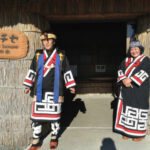by Kevin Carneglia
Did you know there are around 6,500 languages spoken in the world today? Many of them are actually close to extinction. Some of them have as little as one speaker left in the entire world. The death of a language means its people’s stories, customs, and culture can vanish forever. These might be stories of colonization and oppression, slavery, and the hope for a better life. Some of them are undergoing attempts by governments to revive them, while others are actively suppressed by their governments.
Neapolitan

Southern Italy forms the lower part of the “boot” of Italy. Naples, Italy, served as the capital of the Kingdom of Two Sicilies from 1815-1860. After this time period, it was absorbed along with the rest of the South into what is now Italy. The Neapolitan language is considered “vulnerable to extinction” due to a reduction in transmission between generations and the fact that most speakers do not write the language down.
What would be lost if Neapolitan disappeared? The 1925 song Lacreme Napulitane tells the story of an emigrant from Italy to America who struggles with being far from home. The song is in the form of a letter from America, written by a son to his mother back in Naples. The refrain starts with How many tears America has cost us and ends with How bitter is this bread. It is considered the portrait of the immigrant experience at that time.
Yiddish
UNESCO ranks Yiddish, with three million speakers left, as “definitely endangered.” This means children no longer learn the language as a mother tongue in their homes. Yiddish was once spoken by Jewish people from the French province of Alsace to the Ural Mountains. However, the tongue has largely decreased in usage due to Jewish migration from Europe. A number of factors, including antisemitism, Nazism, Stalinism, war, and poverty, were behind this migration.
As Jewish people migrated, some began to learn their new country’s local languages and tried to fit in rather than return to the hardships they’d left behind. However, scholars note that Jewish people wanted to keep links to their homelands while trying to assimilate into their new countries. Of the roughly 16 distinctly Jewish languages, only Yiddish, Aramaic, and Hebrew are considered truly Jewish. This is because they played a dominant role in shaping Jewish culture and because they reflect the way most Jewish persons thought and felt, the basis of their way of life, and the growth and evolution of their spirit.
Scots

The Scots language originated in 600 AD, with the arrival of the Angles in Scotland. This language developed apart from its sister language in England until it was its own language. UNESCO ranks the Scots language as “vulnerable,” meaning most children speak the language, though it may be restricted to certain places such as the home.
There may be political reasons why the Scots language is ranked this way. Scots is closely tied to the identity of Scotland as a nation, and only one political party wants Scots as an official language. Those who oppose Scotland’s independence from the UK likely won’t approve any measures that could fuel dreams of Scotland as a separate nation and thus fracture the United Kingdom. Anti-separation parties would also fear that Scotland could become a signatory in its own right to the European Charter for Regional or Minority Languages. Currently, this right belongs to the Westminster (English) Parliament alone.
The government has financial incentive to suppress this language as well. Returning Scots to prominence would compel the Scottish Parliament to make that language available at all education levels, teach the historical and cultural context of the language, train teachers to implement these changes, and establish an advisory body or bodies that would have to measure the changes and write reports on their outcomes and progress. The sad truth is that this makes for a very expensive and time-consuming process.
Ainu

Ainu is spoken only by a handful of people on the Japanese Island of Hokkaido, with no academic consensus on how Ainu originated. The language has just 15 recorded speakers left and is listed by UNESCO as “critically endangered.” This means the youngest speakers are grandparents and older, who speak the language partially and infrequently. The Ainu lost much of their language to Japanese colonization in 1869, and speakers are hard to find as many hide their heritage.
The Ainu culture could essentially vanish if their language dies out. The Rev. John Batchelor was an English missionary who lived among the Ainu, studying them and publishing works on their language. Batchelor translated various books of the Bible into Ainu and also created a dictionary, a grammar guide, and books written about the native culture in Ainu. In addition to the written word, the Ainu have a rich oral tradition of heroic sagas called Yukars. These sagas were memorized and told at get-togethers and ceremonies lasting hours or even days. Ainu literature includes non-fiction about their history as well as “hunting adventures,” plus fiction regarding their myths, heroes, and magic.
Though only 15 people speak the Hokkaido dialect of Ainu, not all hope is lost for its revival. The Japanese government recognized Ainu as an indigenous language in 2008, and in 2020 finished the construction of a museum dedicated to Ainu culture and language. Other work by individual researchers may help preserve the language as well. Polish anthropologist Bronislaw Pilsudski published a book to help others study the Ainu language and folklore and made audio recordings of the language as well.
Romani
The Romani language is spoken throughout Europe and the USA. With just over three million remaining speakers, Romani is considered “definitely endangered” by UNESCO. This means that children do not learn the language as a mother tongue at home. Based on Sanskrit, Romani has its origins in India. Despite a Slovakian policy recognizing Romani as a national minority language, there is no solid data regarding the number of speakers or the level of speakers in proportion to the total population. This makes it hard to determine how endangered a language may be.
Romani language is credited with telling people about their beginnings and origins, as well as giving them a value system and strengthening their connection to and pride in their roots. It is especially important for children, as it connects to their cultural identity and belief system. The Romani language is partially endangered due to the Holocaust and the assimilationist policies that led to that event. Even today, many Romani are afraid to identify with their native culture and pass their language on to their children.
Preserving Endangered Languages: How You Can Help
Research has shown that instruction in one’s mother tongue, especially from an early age, significantly affects a child’s cognitive development and performance in school. The Council of Europe calls a person’s mother tongue their “…connection with family, society, and culture.”
Luckily, not all is lost regarding these endangered languages and cultures. If you’d like to help save a dying language, here are some actions you can take:
- Master-Apprentice Programs. These programs pair one student with a master speaker of the language. There are Master-Apprentice programs in place for the Potawatomi language, as well as the Indigenous languages of British Columbia.
- Using Tech. Professor Kevin Scannell at the University of St. Louis uses Twitter to find words and phrases from indigenous languages. You can check out his progress at indigenoustweets.org. Apps like Duolingo are also starting to play an important role in spreading and preserving endangered languages. You can also join Wikitongues, a volunteer organization that hosts videos of people speaking minority languages worldwide, thus helping those with no internet connections or access to a trained linguist.
- Check out “Our Mother Tongues,” a film production company that makes documentaries discussing the lives of Native Americans. Through films, archives, and recordings, “Our Mother Tongues” raises awareness about what native peoples are doing to preserve their languages.
Conclusion
This article outlined just some of the roughly 2,900 languages that face endangerment. With the extinction of a language, we also lose the stories, history, and culture attached to the people who once spoke it. Using websites, supporting organizations, and teaching, learning, and speaking the languages are some of the best ways you can help revitalize these endangered languages and the traditions that accompany them.
About the Author
 Kevin Carneglia is a freelance writer and editor. He holds a Bachelor’s Degree in Professional Writing from Western Connecticut State University. Kevin has written for Inquisitr.com, Round Robin Writes, and Blasting News, as well as serving on the editorial board of Fight Cancer Together. He runs his own blog on meditation and healthy living at www.mindtrappings.com. He is the author of A Beginner’s Guide to SEO and Focusing During Meditation on Amazon.
Kevin Carneglia is a freelance writer and editor. He holds a Bachelor’s Degree in Professional Writing from Western Connecticut State University. Kevin has written for Inquisitr.com, Round Robin Writes, and Blasting News, as well as serving on the editorial board of Fight Cancer Together. He runs his own blog on meditation and healthy living at www.mindtrappings.com. He is the author of A Beginner’s Guide to SEO and Focusing During Meditation on Amazon.




